Summary:
The Lens-Free Optical Scanner (LFOS) introduces a paradigm shift in 3D printing by offering a single, integrated solution for both precise material deposition and real-time quality control. This innovative, multifunctional technology transcends the limitations of conventional systems by maintaining consistent energy density across the entire work surface. This ensures exceptional printing accuracy and eliminates inconsistencies regardless of the pixel/voxel location being printed.
LFOS’s unique design with precise focal point control enables dual functionality. It acts as a writing tool, directing the printing beam for accurate material deposition. Crucially, a beam splitter diverts a portion of the printing beam. This reflected or transmitted beam interacts with the deposited material. By analyzing the return beam using the LFOS, the system can sense and read the characteristics of each pixel as it’s printed. This real-time feedback loop creates a comprehensive audit trail for every printed layer. This data becomes invaluable for:
Identifying and rectifying errors during the printing process itself.
Verifying dimensional accuracy and surface quality of printed features.
Optimizing printing parameters for improved consistency and repeatability.
By eliminating the need for separate scanning steps and enabling integrated, real-time process monitoring, LFOS significantly enhances the reliability and efficiency of 3D printing. This paves the way for robust, high-fidelity additive manufacturing with a verifiable record of each printed layer.
Challenges in 3D Printing Quality Control:
Three-dimensional printing (3D printing) is revolutionizing manufacturing by enabling the creation of complex objects directly from digital models. However, ensuring consistent quality across printed layers remains a challenge. Traditional 3D printing techniques, such as Selective Laser Sintering (SLS) and Selective Laser Melting (SLM), often rely on galvanometer scanners to direct the laser beam. These scanners can suffer from inconsistencies in the resulting microstructure across the printed layer due to limitations in their scanning mechanisms [Ref 1].
Furthermore, the energy density delivered by the laser beam in a galvanometer-based system varies depending on its location within the work surface. This variation arises from these limitations and the need to flatten the beam profile. A sensor designed to detect pixel/voxel parameters would face a significant challenge in such a scenario, as it would need to account for these fluctuations in energy density to accurately assess the printed features.
The Lens-Free Optical Scanner (LFOS) emerges as a promising solution to overcome these limitations. Unlike galvanometer scanners, LFOS maintains a constant focal point on the work surface, eliminating distortions and ensuring consistent beam characteristics across the entire printing area. The principle operation of LFOS lies in keeping the focus on a flat surface (Figure 1). In contrast to a Galvanometer-based scanner where the focus is on a spherical-like surface.
Furthermore, LFOS’s unique design allows it to function not only as a writing tool for precise material deposition but also as a real-time sensing system. Since the beam path length remains constant, LFOS can analyze the reflected or transmitted beam to assess the characteristics of each deposited pixel. This real-time feedback loop provides invaluable data for quality control and process optimization in 3D printing. The dual functionality of LFOS is achieved by separating a portion of the printing beam using a beam splitter (Figure 3) or an optical circulator within the fiber (Figure 4). This separated beam is then directed to an optical sensor for analyzing the characteristics of the printed pixel.
By leveraging this unique dual functionality, LFOS offers a significant leap forward in 3D printing capabilities.
Optical Coherence Tomography - OCT Ref [2-7]
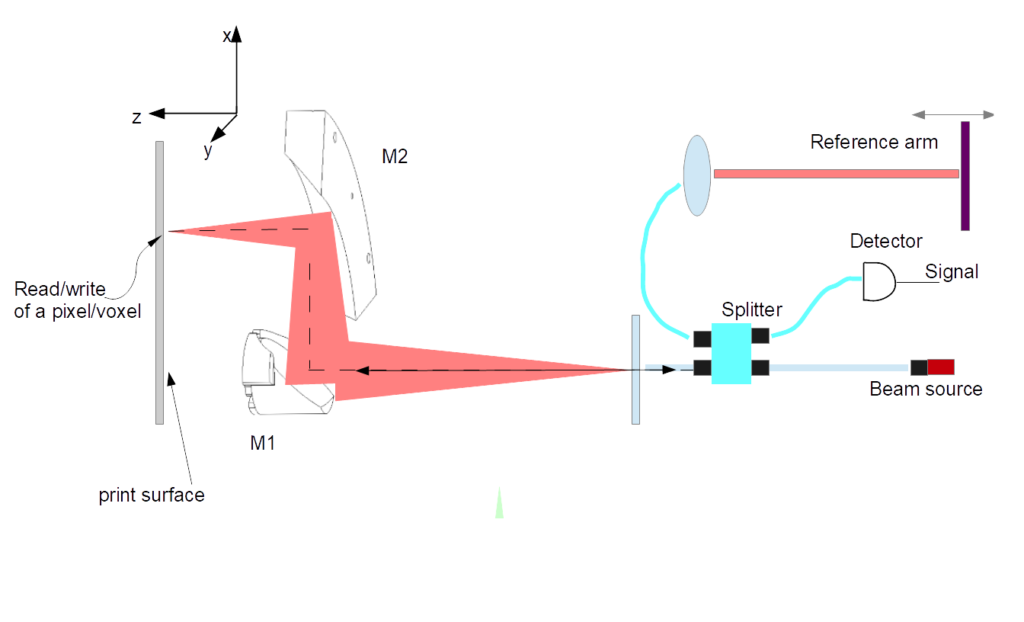
Introduction to OCT and Coherence Principles
Optical Coherence Tomography (OCT) is an imaging technique that leverages the coherence properties of light to capture high-resolution, cross-sectional images of biological tissues. The fundamental working principle of OCT is based on low-coherence interferometry, which involves splitting a light beam into two paths: one directed towards the sample and the other towards a reference mirror.
When light reflects back from different layers within the sample and combines with the light from the reference path, interference patterns are produced. These patterns contain information about the distance and reflectivity of the sample’s internal structures. The degree of interference depends on the coherence length of the light source, which determines how well the light waves overlap. By analyzing these interference signals, OCT systems can generate detailed images of the sample’s internal microstructure.
Time Domain OCT (TD-OCT)
In Time Domain OCT, the imaging process involves scanning the reference arm mechanically. The reference arm is not fixed; it moves back and forth, changing the optical path length of the reference beam. As the reference arm moves, the system captures the interference signal between the reference and sample beams at various depths within the sample. The interference signal is detected over time, and the depth information (A-scan) is obtained by measuring the time delay of the reflected light from different layers within the sample. The axial (depth) resolution in TD-OCT is determined by the coherence length of the light source, while the lateral resolution depends on the focusing optics.
Spectral Domain OCT (SD-OCT)
In Spectral Domain OCT, the reference arm remains fixed, and the system captures depth information by analyzing the light spectrum. Unlike TD-OCT, the reference arm in SD-OCT is stationary, so the optical path length of the reference beam does not change. Light reflected from the sample and the fixed reference arm creates an interference pattern that contains information about all the depths within the sample simultaneously. This interference signal is captured by a spectrometer, which records the spectrum of the combined light. A Fourier transform is applied to this spectral data to extract the depth information (A-scan). SD-OCT typically offers faster image acquisition and higher sensitivity compared to TD-OCT because it captures depth information simultaneously rather than sequentially. The axial resolution in SD-OCT is determined by the bandwidth of the light source, and the lateral resolution is similar to TD-OCT, depending on the focusing optics.
Swept Source OCT (SS-OCT)
Swept Source OCT (SS-OCT) is a variation of SD-OCT that uses a tunable laser as the light source. This method involves rapidly tuning the wavelength (or frequency) of the laser over time. Here’s how it works:
- Tunable Laser: SS-OCT employs a frequency-swept or tunable laser that changes its wavelength in a controlled manner over a range of wavelengths.
- Interference Signal: As the wavelength of the laser sweeps across the spectrum, light reflected from different depths within the sample interferes with the reference beam, creating a time-dependent interference signal.
- Fourier Transform: The interference pattern is detected by a photodetector and then processed using a Fourier transform to obtain depth information. The depth profile is extracted for each wavelength sweep, resulting in an A-scan.
- Speed and Range: SS-OCT systems benefit from high-speed imaging and longer imaging ranges compared to SD-OCT. The tunable laser allows for rapid acquisition of spectral data, enhancing imaging speed and enabling better visualization of deeper structures.
Advantages of Frequency-Swept and Tunable Lasers
Using frequency-swept and tunable lasers in OCT offers several advantages:
- Improved Imaging Speed: The rapid tuning of the laser wavelength allows for fast acquisition of data, making it possible to capture high-speed images.
- Extended Depth Range: SS-OCT can achieve longer imaging depths compared to TD-OCT and SD-OCT, which is beneficial for imaging larger or deeper structures.
- High Sensitivity: The use of a narrow linewidth tunable laser enhances the signal-to-noise ratio, improving the overall sensitivity of the system.
- Versatility: Tunable lasers can be adjusted to specific wavelength ranges, making them suitable for various imaging applications across different tissues and materials.
In summary, TD-OCT uses a moving reference arm to scan depth information sequentially, acquiring one depth point at a time. In contrast, SD-OCT uses a fixed reference arm and captures the entire depth information simultaneously through spectral analysis, offering faster and more sensitive imaging. Swept Source OCT (SS-OCT), a variation of SD-OCT, utilizes a tunable laser that sweeps across wavelengths, providing improved imaging speed, extended depth range, and high sensitivity. By leveraging advanced light sources and spectral analysis, these OCT techniques significantly enhance the speed, sensitivity, and depth of imaging compared to traditional methods.
Future Work: Integration of Optical Coherence Tomography (OCT)
While LFOS provides valuable real-time information about the surface layer being printed, future advancements could integrate Optical Coherence Tomography (OCT) into the system. OCT is a non-destructive imaging technique that utilizes light to provide high-resolution, cross-sectional images of a sample. By incorporating OCT with LFOS, the system could potentially analyze not only the surface but also penetrate deeper into the printed object, offering insights into the quality of underlying layers. This deeper analysis could be particularly beneficial for identifying potential defects like voids or inconsistencies within the printed structure that might not be apparent from surface inspection alone.
Additionally, variations in powder quality can sometimes compromise the integrity of the printed object, even if the LFOS reading indicates a successful deposition on the surface. The integration of OCT would offer a potential solution for detecting such issues. By analyzing the internal structure of the printed layer, the system could identify anomalies caused by variations in powder quality, allowing for corrective actions to be taken during the printing process. This would eliminate the need for destructive testing methods currently used to assess internal quality, further streamlining the 3D printing workflow.
References:
[1] Bibas, C. Lens-Free Optical Scanners for Metal Additive Manufacturing. JOM 74, 1176–1187 (2022). https://doi.org/10.1007/s11837-021-05044-8
[2] Huang, D., Swanson, E. A., Lin, C. P., Schuman, J. S., Stinson, W. G., Chang, W., … & Fujimoto, J. G. (1991). Optical Coherence Tomography. Science, 254(5035), 1178-1181.
[3] Fercher, A. F., Hitzenberger, C. K., Kamp, G., & El-Zaiat, S. Y. (1995). Measurement of intraocular distances by backscattering spectral interferometry. Optics Communications, 117(1-2), 43-48.
[4] Drexler, W., & Fujimoto, J. G. (Eds.). (2008). Optical Coherence Tomography: Technology and Applications. Springer Science & Business Media.
[5] Choma, M. A., Sarunic, M. V., Yang, C., & Izatt, J. A. (2003). Sensitivity advantage of swept source and Fourier domain optical coherence tomography. Optics Express, 11(18), 2183-2189.
[6] Bouma, B. E., & Tearney, G. J. (Eds.). (2002). Handbook of Optical Coherence Tomography. Marcel Dekker, Inc.
[7] Leitgeb, R. A., Hitzenberger, C. K., & Fercher, A. F. (2003). Performance of fourier domain vs. time domain optical coherence tomography. Optics Express, 11(8), 889-894.
[8] Wojtkowski, M., Srinivasan, V. J., Ko, T. H., Fujimoto, J. G., Kowalczyk, A., & Duker, J. S. (2004). Ultrahigh-resolution, high-speed, Fourier domain optical coherence tomography and methods for dispersion compensation. Optics Express, 12(11), 2404-2422.
Figures:
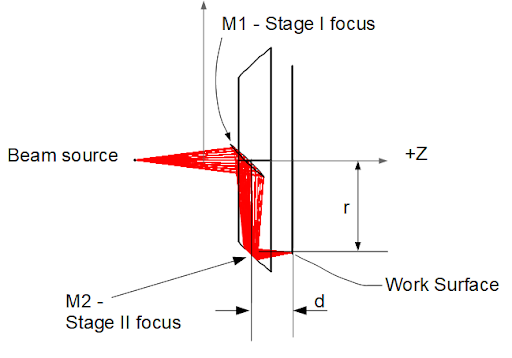
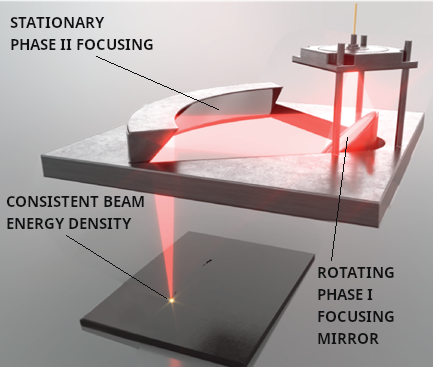
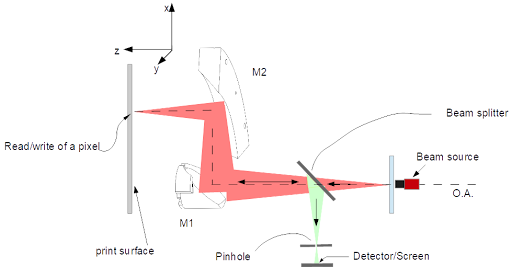
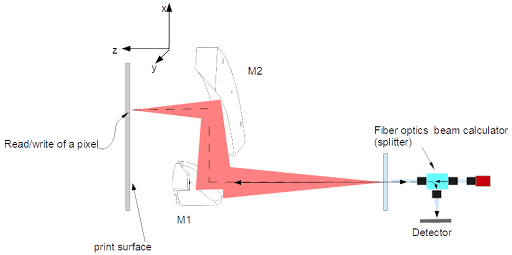
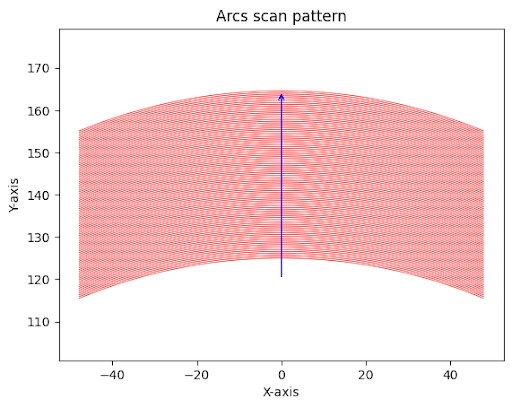
Back to Standards in AM home page






